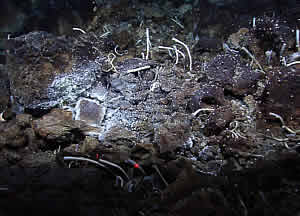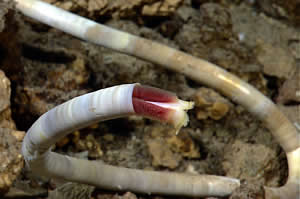
The ŌĆ£moment of discoveryŌĆØ ŌĆō The site where ŌĆśchemosyntheticŌĆÖ shrimp and tubeworms were observed together. Credit: NOAA Okeanos Explorer Program

This was the first live tubeworm seen at a hydrothermal vent site in Atlantic waters. OAA Okeanos Explorer Program
Ocean explorers on NOAA Ship Okeanos Explorer observed two species of marine life scientists believe have never before been seen together at a hydrothermal vent ŌĆ" chemosynthetic shrimp and tubeworms. They also observed the first known live tubeworms ever seen at a hydrothermal vent in Atlantic waters. The discoveries were made August 5-15 during an expedition to the Mid-Cayman Rise south of Grand Cayman Island in the Caribbean.
"On the very first ROV, or remotely-operated vehicle, dive, we observed abundant shrimp of a species different in appearance from other Mid-Atlantic Ridge species," said Professor Paul Tyler, Ph.D., a marine biologist from the University of Southampton in the United Kingdom who was aboard Okeanos Explorer. "These shrimp had characteristics previously seen only on shrimp containing chemosynthetic bacteria, and we identified them as such."
"During the ROV's second dive, we were witness to the first discovery of a live hydrothermal tubeworm in the Atlantic," said expedition Science Lead Chris German, Ph.D., chief scientist for the National Deep Submergence Facility at the Woods Hole Oceanographic Institution in Massachusetts. "I will take that home as my personal key discovery moment for the cruise."
The two discoveries blended into what German described as an even more remarkable discovery. "Not only did we see extensive tube worm communities of differing sizes and shapes across the length and breadth of a large hydrothermal vent field, but we observed for the first time anywhere, chemosynthetic shrimp and tubeworms inhabiting the same hydrothermal site," he said.
"The significance of these observations is that the iconic symbol of Pacific vents is the tubeworm, while the iconic symbol of Atlantic vents is the vent shrimp," added Tyler. "To find both together has important implications for the evolution of vent communities in the Caribbean as the Atlantic became separated from the Pacific some five million years ago."
Chemosynthetic tubeworms and shrimp are unlike most other life on Earth that are photosynthetic ŌĆ" relying on energy from the sun. These new hydrothermal animals, by contrast, exist on the deep and dark ocean floor where no sunlight penetrates. They derive energy instead, from chemicals that rise in the hot water of hydrothermal vents making them chemosynthetic.
Tubeworms rising six feet from the seafloor were first discovered in 1977 next to hydrothermal vents in Pacific waters at the Galapagos near where the underwater tectonic plates spread. Since then, smaller tubeworms have been found at seafloor cold seeps in the Gulf of Mexico, but until this discovery, have not been observed at vents in the Atlantic.
The expedition team used a new model of telepresence-enabled ocean exploration. Few scientists and a larger number of technicians were aboard the ship, however most of the scientists were on watch or on call ashore at a network of Exploration Command Centers that are connected to the ship's sensors, systems and people in near-real time by satellite and high-speed Internet. Scientists ashore participated from centers at the University of Rhode Island and Woods Hole, and other scientists in California, Pennsylvania, Germany, Canada, Portugal and the United Kingdom participated via live video feeds and some through online instant messaging. They played a key role by identifying biological, chemical and geological features shown in ROV images or revealed in data from ocean sensors thousands of miles away.
"From the Mid-Cayman Rise, we used telepresence technology to send data including live video from the seafloor to scientists in many locations ashore where they interacted with scientists and technicians on the ship," said Kelley Elliott, NOAA's Office of Ocean Exploration and Research expedition coordinator. "This new exploration model allows scientists from different disciplines to participate from anywhere in the world no matter the location of the ship and allows the public to experience the excitement of exploration in real time."
This expedition builds on and is collaborative with an on-going NASA project that in 2009 provided the first evidence that hydrothermal sites were awaiting discovery on the Mid-Cayman Rise. Those predictions were confirmed in 2010 with a United Kingdom expedition that obtained the first images of the hydrothermal vents. This 2011 expedition is also proving invaluable to a planned follow-on National Science Foundation mission in January 2012 and a United Kingdom mission early in 2013 that will focus on detailed sampling at and around many of the sites discovered during this mission.
NOAA's partners in the expedition included the University of Rhode Island; Woods Hole Oceanographic Institution; University of Southampton, National Oceanography Centre, Southampton in the United Kingdom; University of Wyoming; Duke University Marine Lab; Marine Biological Laboratory; University Corporation for Atmospheric Research; and the University of New Hampshire.
NOAA Ship Okeanos Explorer is operated, managed and maintained by NOAA's Office of Marine and Aviation Operations, which includes commissioned officers of the NOAA Corps and civilian wage mariners. NOAA OER owns and is responsible for operating and managing the cutting-edge ocean exploration systems on the vessel. It is the only federal ship dedicated to systematic exploration of the planet's largely unknown ocean.
Observing 10 years of ocean exploration, NOAA OER uses state-of-the-art technology to explore Earth's largely unknown ocean in all its dimensions for the purpose of discovery and the advancement of knowledge. Expeditions are chronicled at oceanexplorer.noaa.gov, with images and logs from sea.
